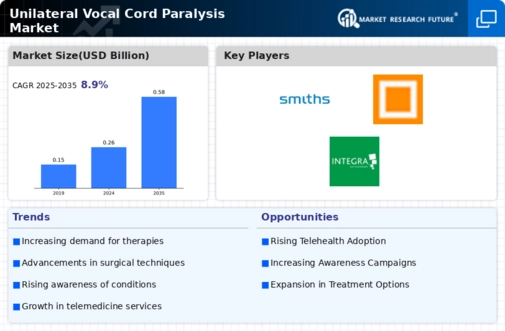Market Trends
Key Emerging Trends in the Unilateral Vocal Cord Paralysis Market
Prevalence and Incidence : UVCP is a condition characterized by the partial or complete paralysis of one vocal cord, often resulting from injury or nerve damage. The market trend reflects a steady increase in both prevalence and incidence rates over recent years, attributed to factors such as aging populations and higher awareness leading to more diagnoses.
Diagnostic Advancements : Technological advancements in diagnostic tools, such as laryngeal electromyography and flexible laryngoscopy, have improved the accuracy and efficiency of UVCP diagnosis. This trend drives market growth as healthcare providers seek reliable methods for early detection and intervention.
Treatment Modalities : The market for UVCP treatment modalities encompasses a range of options, including voice therapy, injection laryngoplasty, and surgical interventions like medialization laryngoplasty. There is a growing demand for minimally invasive procedures and personalized treatment plans tailored to individual patient needs.
Rising Demand for Voice Therapy : Voice therapy, aimed at improving vocal function and reducing symptoms associated with UVCP, is experiencing increased demand. This trend is fueled by greater recognition of the effectiveness of voice therapy in restoring vocal cord function and improving quality of life for patients.
Emerging Biologic Therapies : Biologic therapies, such as stem cell therapy and growth factor injections, are emerging as potential treatments for UVCP. While still in the early stages of development, these innovative approaches hold promise for regenerating damaged vocal cord tissue and addressing the underlying causes of UVCP.
Healthcare Infrastructure Investments : Investments in healthcare infrastructure, particularly in developing regions, are driving market expansion by improving access to diagnosis and treatment services for individuals with UVCP. This trend is supported by initiatives aimed at reducing healthcare disparities and enhancing healthcare delivery systems globally.
Research and Development Efforts : Ongoing research and development efforts focused on understanding the pathophysiology of UVCP and developing novel therapeutic interventions contribute to market growth. Collaboration between academia, industry, and healthcare organizations is key to advancing knowledge and innovation in the field.
Patient-Centric Care Models : There is a shift towards patient-centric care models that prioritize holistic approaches to managing UVCP, addressing not only physical symptoms but also psychosocial and quality of life concerns. This trend underscores the importance of multidisciplinary care teams and patient empowerment in achieving optimal outcomes.
Regulatory Landscape : Regulatory frameworks governing the approval and reimbursement of UVCP treatments play a significant role in shaping market dynamics. Continued efforts to streamline regulatory processes and expand insurance coverage for UVCP therapies are anticipated to facilitate market growth and improve patient access to care.
Global Market Expansion : The UVCP market is witnessing expansion on a global scale, driven by increasing healthcare expenditure, growing patient awareness, and advancements in medical technology. This trend presents opportunities for market players to diversify their product portfolios and reach underserved regions.






Leave a Comment